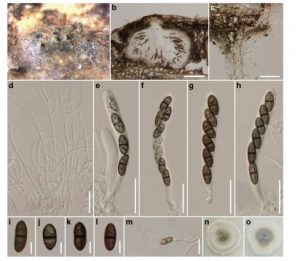Roussoella mukdahanensis Phookamsak, D.Q. Dai & K.D. Hyde, sp. nov. Index Fungorum number : IF552025
Etymology: The epithet mukdahanensis^ refers to the Mukdahan Province, one of the Northeastern provinces in Thailand, where the fungus was found.
Holotype: MFLU 11–0237
Saprobic on dead bamboo culms, forming raised, dark brown areas with black dots on host surface. Sexual morph: Ascostromata pseudostromatic, 280–350 μm high, 520– 880 μm diam., solitary to gregarious, immersed, uni- to multi-loculate. Locules 250–350 μm high, 300–420 μm diam., scattered to clustered, forming groups immersed inascostroma to erumpent through host surface by papilla, globose to subglobose, glabrous, ostioles central, with minute papilla, periphyses. Peridium 15–40 μm wide, thin-walled, of equal thickness, comprising several layers of flattened, brown to dark brown, textura angularis to textura prismatica pseudoparenchymatous cells, textura epidermoidea beside papilla . Hamathecium composed of dense, 1.5–2.5 μm wide, cellular pseudoparaphyses, distinctly septate, not constricted at the septa, branched, anastomosing at the apex, embedded in a gelatinous matrix. Asci (65–)70–80(−89) × (7–)8–10 μm (x = 77.9 × 8.8 μm, n = 30), 4–6–8-spored, bitunicate, cylindrical to cylindric-clavate, short to long pedicellate with furcate or knob-like pedicel, apically rounded with indistinct ocular chamber. Ascospores (10.5–)11– 13(−14) × (4–)5–6 μm (x = 12.4 × 5.4 μm, n = 30), overlapping, uni-seriate, ellipsoidal to fusiform, with rounded to acute ends, brown to dark brown, 1-septate, not constricted at the septum, rough-walled, striate or longitudinally ribbed. Asexual morph: Undetermined.
Culture characters: Colonies on MEA slow growing, 38–40 mm diam. after 4 weeks at 25–30 °C, under 12 h light/12 h dark, colonies irregular, dense, slightly raised to umbonate, dull with undulate edge, floccose tovelvety, slightly radiating, the margin separated by yellowish brown concentric ring, white to cream at the margin, white to grey outwards towards the centre, grey at the centre from above, white to cream at the margin, grey to dark grey at the centre, separated from margin by orangish brown concentric ring from below, not producing pigments.
Material examined: THAILAND, Mukdahan Province, Nongsung District, Wang Hai village, on dead culms of bamboo, 13 April 2011, R. Phookamsak, RP0117 (MFLU 11–0237, holotype); Ibid. (BBH isotype), ex-type living cultures, MFLUCC 11–0201, KUMCC.
Notes: Roussoella mukdahanensis is similar to R. donacicola, R. minutella, R. munkii, R. neopustulans and R. pustulans in the size of asci and ascospores, however, they can be differentiated by their ascostroma size and morphology on the host surface (Saccardo 1891; Aptroot 1995; Ju et al. 1996; Hyde 1997; Liu et al. 2014). Roussoella mukdahanensis is most similar to R. neopustulans and R. pustulans in sharing the size range of asci and ascospores and papillate ostioles in R. neopustulans (Liu et al. 2014). Based on the multi-gene phylogenetic analyses (Fig. 19), Roussoella mukdahanensis distinctly separates from the morphologically similar species. Liu et al. (2014) mentioned that Roussoella species were barely distinguishable by morphological characters, however, they can be separated by phylogenetic investigation.
FIG. Roussoella mukdahanensis (MFLU 11–0237, holotype). a Appearance of scostromata on host surface; b Vertical section through Ascostroma; c Section through peridium; d Pseudoparaphyses; e–h Asci; i–l Ascospores; m Germinating ascospore; n–o Culture characters (n = upper side, o = lower side); Scale bars: b = 100 μm, c = 50 μm, d–h, m = 20 μm, i–l=5 μm

